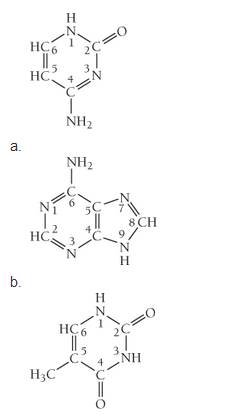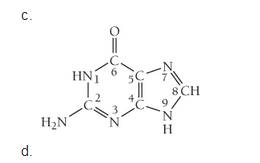
Chemistry: Structure and Properties Plus MasteringChemistry with eText -- Access Card Package
1st Edition
ISBN: 9780321729736
Author: Nivaldo J. Tro
Publisher: PEARSON
expand_more
expand_more
format_list_bulleted
Textbook Question
Chapter 7, Problem 70E
The genetic code is based on four different bases with the structures shown here. Determine the hybridization in each interior atom in these four bases.
a. cytosine
b. adenine
c. thymine
d. guanine


Expert Solution & Answer
Want to see the full answer?
Check out a sample textbook solution
Students have asked these similar questions
Indicate the correct options when referring to Luther's equation:1. It is not always easy to compare its results with experimental results.2. It depends on the number of electrons exchanged in the species involved.3. Its foundation is thermodynamic.4. The values calculated with it do not depend on temperature.
Indicate which of the unit options correspond to a measurement of current density.1. A s m-22. mC s-1 m-23. Ω m-24. V J-1 m-2
Indicate the options that are true when referring to electrode membranes:1. The Donnan potential, in general, does not always intervene in membranes.2. There are several ways to classify the same membrane.3. Any membrane can be used to determine the pH of a solution.4. Only one solution and one membrane are needed to determine the pH of that solution.
Chapter 7 Solutions
Chemistry: Structure and Properties Plus MasteringChemistry with eText -- Access Card Package
Ch. 7 - Determine the hybridization about 0 in CH3OH.Ch. 7 - Determine the hybridization about C in H2CO.Ch. 7 - According to the valance bond theory, which kind...Ch. 7 - Use molecular orbital theory to determine the bond...Ch. 7 - Use molecular orbital theory to predict which...Ch. 7 - Use molecular orbital theory to determine which...Ch. 7 - Which hybridization scheme occurs about nitrogen...Ch. 7 - Prob. 8SAQCh. 7 - Prob. 9SAQCh. 7 - Prob. 10SAQ
Ch. 7 - Which type of orbitals overlap to form the sigma...Ch. 7 - Prob. 12SAQCh. 7 - Prob. 1ECh. 7 - What is a chemical bond according to valence bond...Ch. 7 - In valence bond theory, what determines the...Ch. 7 - In valence bond theory, the interaction energy...Ch. 7 - What is hybridization? Why is hybridization...Ch. 7 - How does hybridization of the atomic orbitals in...Ch. 7 - How is the number of hybrid orbitals related to...Ch. 7 - Sketch each hybrid orbital sp sp2 sp3 sp3d sp3d2Ch. 7 - Prob. 9ECh. 7 - Name the hybridization scheme that corresponds to...Ch. 7 - What is a chemical bond according to molecular...Ch. 7 - Explain the difference between hybrid atomic...Ch. 7 - What is a bonding molecular orbital?Ch. 7 - Prob. 14ECh. 7 - What is the role of wave interference in...Ch. 7 - Prob. 16ECh. 7 - Prob. 17ECh. 7 - Prob. 18ECh. 7 - Prob. 19ECh. 7 - Prob. 20ECh. 7 - Prob. 21ECh. 7 - When applying molecular orbital theory to...Ch. 7 - In molecular orbital theory, what is a nonbonding...Ch. 7 - Write a short paragraph describing chemical...Ch. 7 - Prob. 25ECh. 7 - Prob. 26ECh. 7 - Prob. 27ECh. 7 - Prob. 28ECh. 7 - Prob. 29ECh. 7 - Prob. 30ECh. 7 - The valence electron configurations of several...Ch. 7 - The valence electron configurations of several...Ch. 7 - Draw orbital diagrams (boxes with arrows in them)...Ch. 7 - Draw orbital diagrams (boxes with arrows in them)...Ch. 7 - Prob. 35ECh. 7 - Draw orbital diagrams (boxes with arrows in them)...Ch. 7 - Which hybridization scheme allows the formation of...Ch. 7 - Which hybridization scheme allows the central atom...Ch. 7 - Write a hybridization and bonding scheme for each...Ch. 7 - Write a hybridization and bonding scheme for each...Ch. 7 - Write a hybridization and bonding scheme for each...Ch. 7 - Write a hybridization and bonding scheme for each...Ch. 7 - Write a hybridization and bonding scheme for each...Ch. 7 - Write a hybridization and bonding scheme for each...Ch. 7 - Consider the structure of the amino acid alanine...Ch. 7 - Consider the structure of the amino acid aspartic...Ch. 7 - Sketch the bonding molecular orbital that results...Ch. 7 - Sketch the antibonding molecular orbital that...Ch. 7 - Draw an MO energy diagram and predict the bond...Ch. 7 - Draw an MO energy diagram and predict the bond...Ch. 7 - Sketch the bonding and antibonding molecular...Ch. 7 - Sketch the bonding and antibonding molecular...Ch. 7 - Using the molecular orbital energy ordenng for...Ch. 7 - Using the molecular orbital energy ordering for...Ch. 7 - Apply molecular orbital theory to predict if each...Ch. 7 - Apply molecular orbital theory to predict if each...Ch. 7 - According to MO theory, which molecule or ion has...Ch. 7 - According to MO theory, which molecule or ion has...Ch. 7 - Draw an MO energy diagram for CO. (Use the energy...Ch. 7 - Draw an MO energy diagram for HCI. Predict the...Ch. 7 - Prob. 61ECh. 7 - Prob. 62ECh. 7 - Prob. 63ECh. 7 - Prob. 64ECh. 7 - Prob. 65ECh. 7 - Prob. 66ECh. 7 - For each compound, draw the Lewis structure,...Ch. 7 - For each compound, draw the Lewis structure,...Ch. 7 - Amino acids are biological compounds that link...Ch. 7 - The genetic code is based on four different bases...Ch. 7 - The structure of caffeine, present in coffee and...Ch. 7 - The structure of acetylsalicylic acid (aspirin) is...Ch. 7 - Draw a molecular orbital energy diagram for CIF....Ch. 7 - Draw Lewis structures and MO diagrams for CN+, CN,...Ch. 7 - Bromine can form compounds or ions with any number...Ch. 7 - The compound C3H4 has two double bonds. Describe...Ch. 7 - How many hybrid orbitals do we use to describe...Ch. 7 - Prob. 78ECh. 7 - In VSEPR theory, which uses the Lewis model to...Ch. 7 - The resuts of a molecular orbital calculation for...Ch. 7 - Prob. 81ECh. 7 - cis-2-Butene isomerizes (changes its structure) to...Ch. 7 - The ion CH5 + can form under very special...Ch. 7 - Neither the VSEPR model nor the hybridization...Ch. 7 - Prob. 85ECh. 7 - The most stable forms of the nonmetals in groups...Ch. 7 - Consider the bond energies of three iodine...Ch. 7 - How many atomic orbitals form a set of sp3hybrid...
Knowledge Booster
Learn more about
Need a deep-dive on the concept behind this application? Look no further. Learn more about this topic, chemistry and related others by exploring similar questions and additional content below.Similar questions
- Calculate the maximum volume of carbon dioxide gasarrow_forwardIn galvanic cells, their potential1. can be measured with a potentiometer2. does not depend on the equilibrium constant of the reaction occurring within them3. is only calculated from the normal potentials of the electrodes they comprise4. can sometimes be considered a variation in a potential differencearrow_forwardIf some molecules in an excited state collide with other molecules in a ground state, this process1. can occur in solution and in the gas phase.2. can be treated as a bimolecular process.3. always results in collisional deactivation.4. does not compete with any other process.arrow_forward
- Radiation of frequency v is incident on molecules in their ground state. The expected outcome is that1. the molecules do not change their state.2. the molecules transition to an excited state.3. the molecules undergo a secondary process.4. collisional deactivation occurs.arrow_forwardPredict the major product of the following reaction and then draw a curved arrow mechanism for its formation. Part: 0/2 Part 1 of 2 H₂SO heat : OH 90 Draw the structure of the major product. Click and drag to start drawing a structure. 3arrow_forwardDraw a curved arrow mechanism for the reaction, adding steps as necessary. Be sure to include all electrons that are necessary to the mechanism and all nonzero formal charges. C Ö-H H + -S-OH .0. Add/Remove step X टे Click and drag to start drawing a structure.arrow_forward
- Draw a curved arrow mechanism for its formation. You may need to re-draw structures to show certain bonds. Ensure that HSO is used as the base to deprotonate the ẞ carbon when necessary. C HO : OH HO: OH =s = + 1 Add/Remove step X Click and drag to start drawing a structure.arrow_forwardWhich of the following could 1,2-ethanediol be directly synthesized from? OH HO О 0 0. O ?arrow_forwardDesign a synthesis of 1,2-diethoxyethane from an alkene. Select the single best answer for each part. Part: 0/3 Part 1 of 3 Which of the following could 1,2-diethoxyethane be directly synthesized from? O HO 0 HO.... OH HO HO × 5 > ?arrow_forward
arrow_back_ios
SEE MORE QUESTIONS
arrow_forward_ios
Recommended textbooks for you
 Chemistry & Chemical ReactivityChemistryISBN:9781337399074Author:John C. Kotz, Paul M. Treichel, John Townsend, David TreichelPublisher:Cengage Learning
Chemistry & Chemical ReactivityChemistryISBN:9781337399074Author:John C. Kotz, Paul M. Treichel, John Townsend, David TreichelPublisher:Cengage Learning Chemistry & Chemical ReactivityChemistryISBN:9781133949640Author:John C. Kotz, Paul M. Treichel, John Townsend, David TreichelPublisher:Cengage Learning
Chemistry & Chemical ReactivityChemistryISBN:9781133949640Author:John C. Kotz, Paul M. Treichel, John Townsend, David TreichelPublisher:Cengage Learning Chemistry: Principles and PracticeChemistryISBN:9780534420123Author:Daniel L. Reger, Scott R. Goode, David W. Ball, Edward MercerPublisher:Cengage Learning
Chemistry: Principles and PracticeChemistryISBN:9780534420123Author:Daniel L. Reger, Scott R. Goode, David W. Ball, Edward MercerPublisher:Cengage Learning Chemistry: The Molecular ScienceChemistryISBN:9781285199047Author:John W. Moore, Conrad L. StanitskiPublisher:Cengage Learning
Chemistry: The Molecular ScienceChemistryISBN:9781285199047Author:John W. Moore, Conrad L. StanitskiPublisher:Cengage Learning Chemistry for Engineering StudentsChemistryISBN:9781337398909Author:Lawrence S. Brown, Tom HolmePublisher:Cengage LearningChemistry: Matter and ChangeChemistryISBN:9780078746376Author:Dinah Zike, Laurel Dingrando, Nicholas Hainen, Cheryl WistromPublisher:Glencoe/McGraw-Hill School Pub Co
Chemistry for Engineering StudentsChemistryISBN:9781337398909Author:Lawrence S. Brown, Tom HolmePublisher:Cengage LearningChemistry: Matter and ChangeChemistryISBN:9780078746376Author:Dinah Zike, Laurel Dingrando, Nicholas Hainen, Cheryl WistromPublisher:Glencoe/McGraw-Hill School Pub Co

Chemistry & Chemical Reactivity
Chemistry
ISBN:9781337399074
Author:John C. Kotz, Paul M. Treichel, John Townsend, David Treichel
Publisher:Cengage Learning

Chemistry & Chemical Reactivity
Chemistry
ISBN:9781133949640
Author:John C. Kotz, Paul M. Treichel, John Townsend, David Treichel
Publisher:Cengage Learning

Chemistry: Principles and Practice
Chemistry
ISBN:9780534420123
Author:Daniel L. Reger, Scott R. Goode, David W. Ball, Edward Mercer
Publisher:Cengage Learning

Chemistry: The Molecular Science
Chemistry
ISBN:9781285199047
Author:John W. Moore, Conrad L. Stanitski
Publisher:Cengage Learning

Chemistry for Engineering Students
Chemistry
ISBN:9781337398909
Author:Lawrence S. Brown, Tom Holme
Publisher:Cengage Learning

Chemistry: Matter and Change
Chemistry
ISBN:9780078746376
Author:Dinah Zike, Laurel Dingrando, Nicholas Hainen, Cheryl Wistrom
Publisher:Glencoe/McGraw-Hill School Pub Co
Linear Combination of Atomic Orbitals LCAO; Author: Edmerls;https://www.youtube.com/watch?v=nq1zwrAIr4c;License: Standard YouTube License, CC-BY
Quantum Molecular Orbital Theory (PChem Lecture: LCAO and gerade ungerade orbitals); Author: Prof Melko;https://www.youtube.com/watch?v=l59CGEstSGU;License: Standard YouTube License, CC-BY